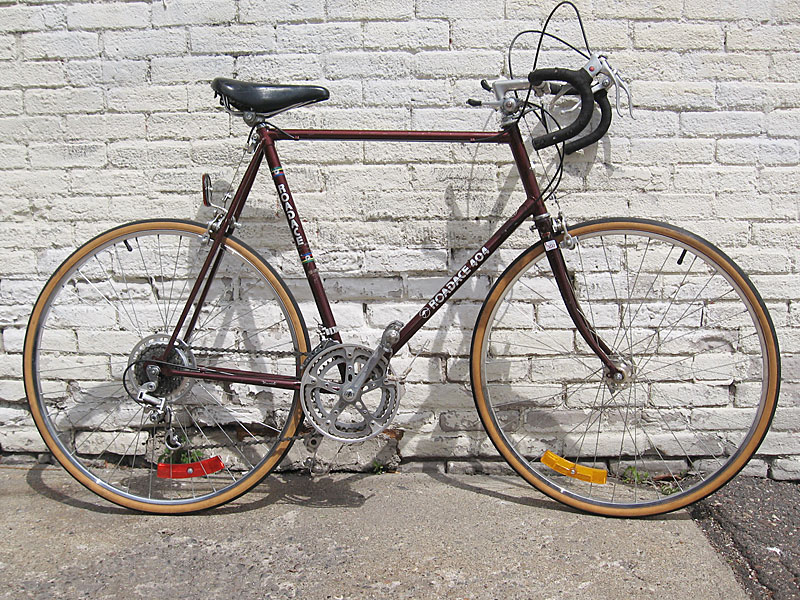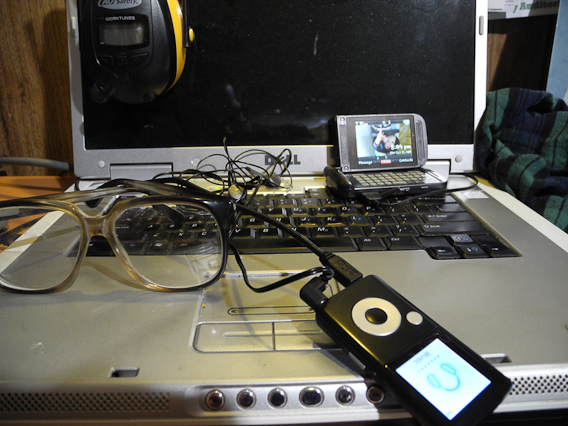 Tom Hayden, an ex-LWONian whom we miss beyond measure, posted this on Nov. 2, 2011. At the time it seemed to hit a national nerve, but knowing Tom, we bet every detail of it is still true.
Tom Hayden, an ex-LWONian whom we miss beyond measure, posted this on Nov. 2, 2011. At the time it seemed to hit a national nerve, but knowing Tom, we bet every detail of it is still true.
I’ve been thinking about my Zune a lot since Steve Jobs passed away. You know, the revolutionary portable music device that lets users carry thousands of digitized songs around in a pocket or a purse? Oh wait, what am I saying — it’s not a Microsoft product I’ve been thinking about. I don’t have a Zune. I don’t even have an iPod. I have a Coby.
That’s right, a Coby. A cheap plastic mp3 player — basically a $19.99 flash drive with a headphone jack, a pixilated little screen, and controls that look a lot like the original iPod scroll wheel, without actually scrolling or being a wheel. It’s a piece of crap, really. And I love it.
I mean no disrespect to Jobs or his legacy of attractive, functional design at Apple. I actually did have an iPod once, a sleek 30-gig number with a brilliant video screen and space for nearly half of my comically large music collection. I watched a video on it exactly once—Breaking Bad, season one—cringed with horror every time I dropped it and felt the $400 hole in my wallet for longer than I’d owned the thing when I inevitably lost it.

But I don’t miss it. The iPod’s much-lauded shuffle function was apparently designed to highlight the far corners and aesthetic lapses of my song library. Ironic curios such as Hasselhoff, Shatner and the suppressed first Alanis Morissette CDs recurred frequently enough to constitute harassment. Having a dinner party? iTunes selected powwow drumming. Looking for a jolt of energy in the morning? Say hello to mediocre Canadian whinge-rock from 20 years ago.
My portable audio technology needs are simple. A few hundred well-chosen—by me, dammit—songs and a half-dozen episodes of the WTF podcast and I’m good to go. My trusty Coby does all that, with an FM radio tuner included. (I do wish it had AM too—the crap technology of the air—but why gripe?) Most important, it’s worth next to nothing so I’m virtually assured never to lose it—unlike apparently every iPhone prototype ever—and I don’t cringe at all when my toddler flings it across the room. And because the next Coby is sure to be just as mediocre, I’ll never need to upgrade—I’ve stepped off the escalators of feature creep and planned obsolescence, and all the expense and toxic e-waste that come with them. Crap technology, it turns out, is green technology.
My love of the technological mediocrity goes back at least to 1980. My birthday present that year was a new bike—a 12 speed no less. Oh sure, my friends on their Peugeots and Raleighs mocked, but the Roadace 404 has outlasted them all. I’m not sure I ever saw another bike of its (off-) brand on the road, but it saw me through more than a decade of heavy use, and my sister still rides it today.
Me, I ride a 1995 mountain bike—practically new, I know, but blissfully free of shock absorbers and disk brakes. I’ve experimented with a variety of advanced travel mugs to tote a dose of morning coffee on my bike-train-bike commute. They were beautifully designed, and capable of keeping the contents plenty hot enough to scald each time their complicated drinking lids dripped slowly into my lap or dumped wholesale into my backpack. I’ve given up, reverting to an old pasta sauce jar with a fail-proof lid and the decency to let the coffee cool enough to be drinkable by the time I’m ready for it.
 Cell phones present the greatest challenge for the dedicated non-technologist. After losing three or four earlier models, I’ve settled on a not-smart-at-all Samsung that makes and receives phone calls (I don’t pick up) and has a non-virtual qwerty keyboard that is forgiving of my sausage-fingered texting. The devilish thing apparently also has the power to connect to the Internet, but I refused to walk out of the store with the device until that feature was safely shut down. Here’s what’s smart about my humble Samsung: I spend approximately zero hours a day fumbling around with silly games, or trying to enjoy the latest from longreads.com on a screen the size of child’s tongue.
Cell phones present the greatest challenge for the dedicated non-technologist. After losing three or four earlier models, I’ve settled on a not-smart-at-all Samsung that makes and receives phone calls (I don’t pick up) and has a non-virtual qwerty keyboard that is forgiving of my sausage-fingered texting. The devilish thing apparently also has the power to connect to the Internet, but I refused to walk out of the store with the device until that feature was safely shut down. Here’s what’s smart about my humble Samsung: I spend approximately zero hours a day fumbling around with silly games, or trying to enjoy the latest from longreads.com on a screen the size of child’s tongue.
My favorite piece of also-ran technology though is a simple pair of glasses. They were the rump-end of a buy one, get one free deal back in the ‘90s — the least awful of an almost perversely unlovely selection. I soon found that their vast, full moon plastic lenses made them a perfect substitute for safety goggles in the chemistry lab, and thanks to the unlosability law of lousy gear, they never went overboard during months of oceanography fieldwork, and I deploy them still whenever I’m doing a little handy work around the house. (Ask me about my collection of cast-off power tools.)
Does second-rate technology have a future? It’s not for me to say. But my son, at 18 months, seems to think so. Not only does he love my “Zune”—easier for a toddler to say than “Coby” I suppose—but his own favorite technology is a little crappy, too. It’s a second-hand wooden garbage truck, hand assembled by its previous owner and re-glued any number of times by me. Our kid loves the thing like the rest of us are supposed to love the new iPhone. I suspect that means crap technology has a future as bright and shiny as anything Steve Jobs ever imagined.
***
11/17/2011. I’ve heard from a lot of people since this post first went up, and I’m delighted to discover how many kindred spirits I have. Several people have pointed out though that it can be hard to tell the difference between “crap” technology–functional stuff with no cachet–and the truly “crappy.” No one wants the latter, and there’s nothing green about using something once and throwing it out because it doesn’t work. But how can you tell the difference? Fortunately, I have a crack team of super-smart Stanford students who are standing by, waiting to answer this and all of your environmental questions. We call it SAGE: Sound Advice for a Green Earth. You can read through scores of answers in our archive, or ask your own questions here.
***
Images Top: The Roadace 404 just gets better with age. Middle: You were expecting Fabio? Bottom: My technology is awesome.
Thank you Thomas Hayden for helping keep poison out of landfills and air. New junk that is not manufactured, bought, and discarded saves our environment and resources.
I’ve owned a Sylvania non-LCD non even flat screen TV for over 11 years, and it still works like a charm, more than twice as long as my previous Sony lemon. Like a previous commenter, I also own a Sansa Clip (perhaps not true crap as it’s made by the reputable Sandisk company), accidentally doused it with liquid non-dairy creamer, and the thing just keeps on ticking! (gotta be more careful though). My cell phone is an LG 300 that cost about the price of a Big Mac meal. No internet, no apps, a couple of lame games, and a minimalist texting feature, but it’s got everything i need and want in a phone.
I’m with the ones who opt for quality and take care of their purchases. I buy good and keep stuff until it dies or I need a hardware update to keep up with the software. The only reason I went to an iPhone at this point was due to the theft of my purse and the loss of my fliptop LG (8300?) phone (great phone, great sound, great reception), the low end camera I carry around all the time and my early iPod Touch which still worked fine after heavy use (always protected with a sturdy bumper type case, glass exposed.) I have an obscenely expensive sweater given to me by a friend who wore it constantly for 6 years, I’ve had it for 3 years, wear it a lot and expect it to last a lot longer. My mother had clothes made for her in the 50’s (we weren’t wealthy, she just blew a lot of cash on clothes). I still have a few pieces that are still wearable. Most vintage clothing left these days is of good quality. It isn’t the objects that are at fault, it’s the attitudes of the owners. Take care of it and it will take care of you!
I think many people like the idea of buying quality products that last. But I think the line between quality and crap is more blurred than it used to be. There was a time when price and brand name seemed to be a pretty safe guide to whether a product was “quality” or “cheap.” But now, most of us have been burned by the expensive brand name item that quickly failed – or have bought something inexpensive that we assumed was a throw-away and it just would not die. So many manufacturers buy parts from the same suppliers, while even companies with great reputations look for ways to cut costs – sometimes at the expense of quality. When you buy a second tier brand product and it fails, you may tell yourself that you should have known better – but you can rationalize that it wasn’t all that expensive to begin with. When you buy the expensive brand and it fails, you feel like a chump for believing the conventional wisdom that an expensive brand name will work better and last longer.